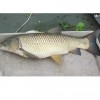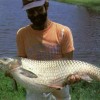 The grass carp, Ctenopharyngodon idella Cuvier and Valenciennes, was imported to the U.S. in 1963 as a biological control agent for hydrilla (Hydrilla verticilliata (L.f.) Royle) and other aquatic plants. Concerns of escape and reproduction, and the potential impacts that colonization of the fish could have on native flora and fauna led to research that developed a non-reproductive fish, which was equally effective in controlling hydrilla. In the warm waters of Florida, with abundant food, grass carp grow quickly at around 2 lbs/month or 0.91 kg/month and may achieve weights of 97 lbs (44 kg). Younger fish and female fish grow faster than older or male fish. Grass carp are the most effective biological control tool that has been identified for hydrilla. This 7-page fact sheet was written by Emma N.I. Weeks and Jeffrey E. Hill, and published by the UF Department of Entomology and Nematology, June 2014.
The grass carp, Ctenopharyngodon idella Cuvier and Valenciennes, was imported to the U.S. in 1963 as a biological control agent for hydrilla (Hydrilla verticilliata (L.f.) Royle) and other aquatic plants. Concerns of escape and reproduction, and the potential impacts that colonization of the fish could have on native flora and fauna led to research that developed a non-reproductive fish, which was equally effective in controlling hydrilla. In the warm waters of Florida, with abundant food, grass carp grow quickly at around 2 lbs/month or 0.91 kg/month and may achieve weights of 97 lbs (44 kg). Younger fish and female fish grow faster than older or male fish. Grass carp are the most effective biological control tool that has been identified for hydrilla. This 7-page fact sheet was written by Emma N.I. Weeks and Jeffrey E. Hill, and published by the UF Department of Entomology and Nematology, June 2014.
http://edis.ifas.ufl.edu/in1038
Tag: Carp
Grass Carp: A Fish for Biological Management of Hydrilla and Other Aquatic Weeds in Florida (BUL867/FA043)
 Abundant growth of aquatic plants causes serious problems in ponds, lakes, rivers, and irrigation and drainage throughout Florida. In some situations, native aquatic plants become weeds, but most often exotic plants introduced from areas outside the state flourish under the favorable growing conditions found in Florida. Long-term economical solutions to Florida’s aquatic weed problems have been elusive and there is a need for control techniques to alleviate aquatic weed problems. This 6-page fact sheet provides information on a biological method, the grass carp, for management of some of Florida’s aquatic weed problems. Written by David L. Sutton and Vernon V. Vandiver, Jr., and published by the UF Department of Fisheries and Aquatic Sciences, November 2013.
Abundant growth of aquatic plants causes serious problems in ponds, lakes, rivers, and irrigation and drainage throughout Florida. In some situations, native aquatic plants become weeds, but most often exotic plants introduced from areas outside the state flourish under the favorable growing conditions found in Florida. Long-term economical solutions to Florida’s aquatic weed problems have been elusive and there is a need for control techniques to alleviate aquatic weed problems. This 6-page fact sheet provides information on a biological method, the grass carp, for management of some of Florida’s aquatic weed problems. Written by David L. Sutton and Vernon V. Vandiver, Jr., and published by the UF Department of Fisheries and Aquatic Sciences, November 2013.
http://edis.ifas.ufl.edu/fa043